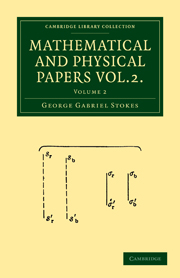Book contents
- Frontmatter
- Contents
- Notes on Hydrodynamics. III. On the Dynamical Equations
- On the constitution of the Luminiferous Ether
- On the Theory of certain Bands seen in the Spectrum
- Notes on Hydrodynamics. IV. Demonstration of a Fundamental Theorem
- On a difficulty in the Theory of Sound
- On the Formation of the Central Spot of Newton's Rings beyond the Critical Angle
- On some points in the Received Theory of Sound
- On the perfect Blackness of the Central Spot in Newton's Rings, and on the Verification of Fresnel's Formula for the intensities of Reflected and Reflacted Rays
- On Attractions, and on Clairaut's Theorem
- On the Variation of Gravity at the Surface of the Earth
- On a Mode of Measuring the Astigmatism of a Defective Eye
- On the Determination of the Wave Length corresponding with any Point of the Spectrum
- Discussion of a Differential Equation relating to the Breaking of Railway Bridges
- Notes on Hydrodynamics, VI. On Waves
- On the Dynamical Theory of Diffraction
- On the Numerical Calculation of a class of Definite Integrals and Infinite Series
- On the Mode of Disappearance of Newton's Rings in passing the Angle of Total Internal Reflection
- On Metallic Reflection
- On a Fictitious Displacement of Fringes of Interference
- On Haidinger's Brushes
- Index
On a Mode of Measuring the Astigmatism of a Defective Eye
Published online by Cambridge University Press: 07 September 2010
- Frontmatter
- Contents
- Notes on Hydrodynamics. III. On the Dynamical Equations
- On the constitution of the Luminiferous Ether
- On the Theory of certain Bands seen in the Spectrum
- Notes on Hydrodynamics. IV. Demonstration of a Fundamental Theorem
- On a difficulty in the Theory of Sound
- On the Formation of the Central Spot of Newton's Rings beyond the Critical Angle
- On some points in the Received Theory of Sound
- On the perfect Blackness of the Central Spot in Newton's Rings, and on the Verification of Fresnel's Formula for the intensities of Reflected and Reflacted Rays
- On Attractions, and on Clairaut's Theorem
- On the Variation of Gravity at the Surface of the Earth
- On a Mode of Measuring the Astigmatism of a Defective Eye
- On the Determination of the Wave Length corresponding with any Point of the Spectrum
- Discussion of a Differential Equation relating to the Breaking of Railway Bridges
- Notes on Hydrodynamics, VI. On Waves
- On the Dynamical Theory of Diffraction
- On the Numerical Calculation of a class of Definite Integrals and Infinite Series
- On the Mode of Disappearance of Newton's Rings in passing the Angle of Total Internal Reflection
- On Metallic Reflection
- On a Fictitious Displacement of Fringes of Interference
- On Haidinger's Brushes
- Index
Summary
Besides the common defects of long sight and short sight, there exists a defect, not very uncommon, which consists in the eye's refracting the rays of light with different power in different planes, so that the eye, regarded as an optical instrument, is not symmetrical about its axis. This defect was first noticed by the present Astronomer Royal in a paper published about 20 years ago in the Transactions of the Cambridge Philosophical Society. It may be detected by making a small pin-hole in a card, which is to be moved from close to the eye to arm's length, the eye meanwhile being directed to the sky, or any bright object of sufficient size. With ordinary eyes the indistinct image of the hole remains circular at all distances; but to an eye having this peculiar defect it becomes elongated, and, when the card is at a certain distance, passes into a straight line. On further removing the card, the image becomes elongated in a perpendicular direction, and finally, if the eye be not too long-sighted, passes into a straight line perpendicular to the former. Mr Airy has corrected the defect in his own case by means of a spherico-cylindrical lens, in which the required curvature of the cylindrical surface was calculated by means of the distances of the card from the eye when the two focal lines were formed.
- Type
- Chapter
- Information
- Mathematical and Physical Papers , pp. 172 - 175Publisher: Cambridge University PressPrint publication year: 2009First published in: 1883
- 2
- Cited by



